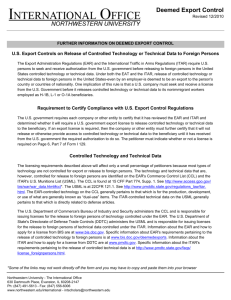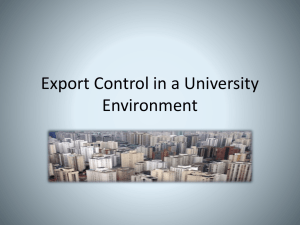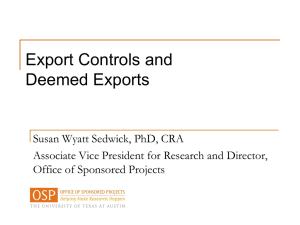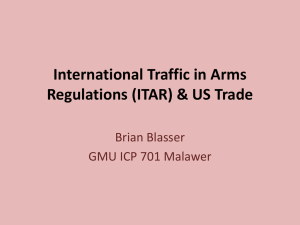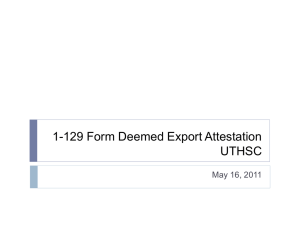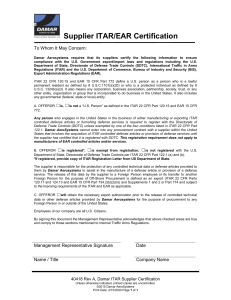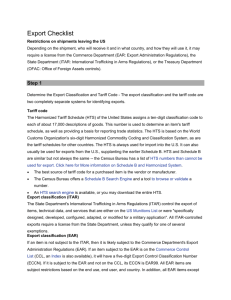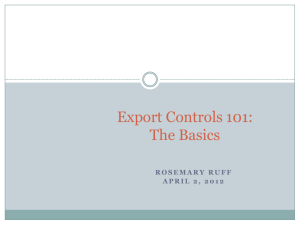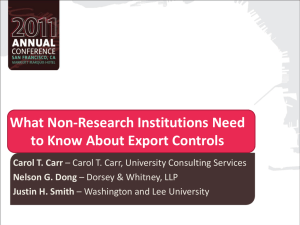Presentation Title Will Appear Here
advertisement
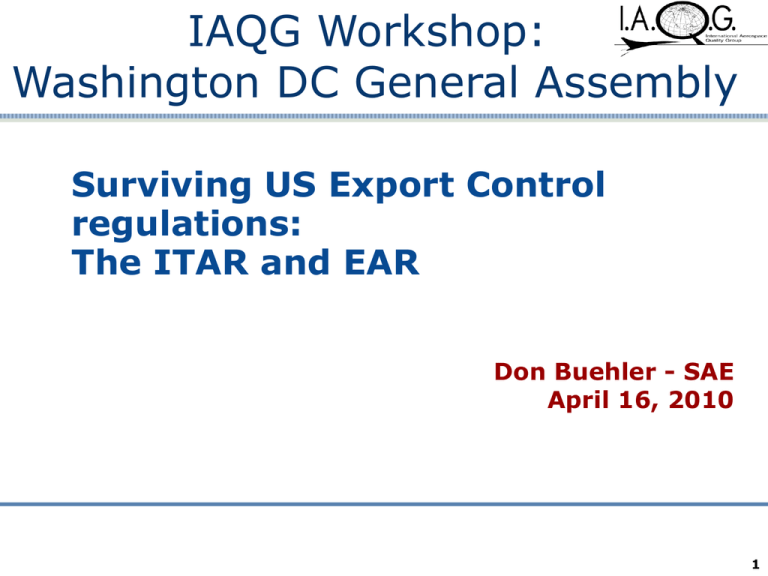
IAQG Workshop: Washington DC General Assembly Surviving US Export Control regulations: The ITAR and EAR Don Buehler - SAE April 16, 2010 Company Confidential 1 Topics we will cover: •Why should aerospace companies care? •How does the US government control exports? •How are companies affected by these laws? 2 Why should aerospace companies care? 1. Most aerospace companies work on U.S. origin items 2. Many of these items are restricted by US Export laws and regulations 3. The laws and regulations apply to all companies or individuals who have possession of restricted items 3 Why should aerospace companies care? 4. Aerospace companies and individuals are regularly prosecuted – fined or debarred for violations of the laws and regulations 4 EXAMPLES: 1. DHL fined $9.44 million DHL Owned by: Deutsche Post World Net / Deutsche Post DHL – a German company This was the largest fine in history for a freight forwarder. Their violations: primarily record keeping (Aug 2009) 5 EXAMPLES: 2. Thermon Mfg Co fined $176,000 Three affiliates (in India & the UK) committed 33 violations – reexporting restricted items without a license and exporting to embargoed countries and to debarred companies (Sept 2009) 6 EXAMPLES: 3. Quoptiq fined $25 Million A Luxembourg LLC 163 violations of the ITAR Exported night vision technology without proper licenses to various European and Asian companies (December 2008) 7 EXAMPLES: 4. Bass Pro Shops fined Violation: Gun Sights Between June 1999 and January 2004, Bass Pro, Inc. exported gun sights to a variety of destinations without a license in violation of the EAR. Gun sights are controlled pursuant to U.S. treaty obligations, as well as for human rights and anti-terrorism reasons. Bass Pro agreed to pay an administrative penalty of $510,000. 8 8 8 EXAMPLES: TFC Mfg – aerospace fabrications company • TFC Manufacturing, Inc. The Violation: Between March and April 2006, TFC Manufacturing, Inc. (TFC), a Lakewood, California- based aerospace fabrication facility, released U.S-origin technology for the production of aircraft parts (classified under ECCN 9E991) to an Iranian national employee in the U.S. without the required license under the EAR. The Penalty:TFC agreed to pay a $31,500 administrative penalty. 9 Maximum Penalties EAR Civil penalties may be the greater of $250,000 or twice the value of the transactions Criminal violations may be up to $1,000,000 and/or 20 years imprisonment ITAR Civil fines up to $500,000 per violation Criminal fines up to $1,000,000 per violation and/or 10 years imprisonment 10 10 The question: • Does your company work on U.S. origin products or have possession of US technical data? • Does your company understand the US laws and regulations? • Is your company vulnerable to violations? The purpose of this presentation is to raise your awareness of the laws and regulations which may be affecting your company right now – and to give you some basic information on the regulations. 11 The BASICS •There are two major regulations which affect US exports: - The International Traffic in Arms Regulations (22 CFR Chapter I, Subchapter M) - ITAR And - The Export Administration Regulations (15 CFR Part 700 – 799) - EAR 12 The BASICS - ITAR • The ITAR is administered by the US Department of State – Office: Directorate of Defense Trade Controls (DDTC) • The ITAR controls defense articles and defense services which are listed on the United States Munitions List (USML) (Part 121) 13 The United States Munitions List (USML) (Part 121) Category I Firearms, Close Assault Weapons and Combat Shotguns Category VI Vessels of War and Special Naval Equipment Category II Guns and Armament Category VII Tanks and Military Vehicles Category III Ammunition/Ordnance Category VIII Aircraft and Associated Equipment Category IV Category IX Military Training Equipment and Training Launch Vehicles, Guided Missiles, Ballistic Missiles, Rockets, Torpedoes, Bombs and Mines Category V Explosives and Energetic Materials, Propellants, Incendiary Agents and Their Constituents) 14 Category X Protective Personal Equipment and Shelters The United States Munitions List (USML) (Part 121) Category XI Military Electronics Category XVI Nuclear Weapons, Design and Testing and Related Items Category XII Fire Control, Range Finder, Optical and Guidance and Control Equipment Category XVII Classified Articles, Technical Data and Defense Services Not Otherwise Enumerated Category XIII Auxiliary Military Equipment Category XVII Directed Energy Weapons Category XIV Category XIX Reserved Category XX Submersible Vessels, Oceanographic and Associated Equipment Toxicological Agents, Including Chemical Agents, Biological Agents, and Associated Equipment Category XV Spacecraft Systems and Associated Equipment 15 Category XXI Miscellaneous Articles ITAR Licensing If the item you are exporting has been designed for a military application And is listed on the USML you will have to get a license for the export (unless there is an exemption) 16 DDTC registration requirement • Does your company work on defense items or perform defense services (as described in the United States Munitions List)? • If so, your company is required to be registered with the U.S. Department of State, Directorate of Defense Trade Controls (DDTC). • Refer to Section 122 of the ITAR 17 The BASICS - EAR • The EAR is administered by the US Commerce Dept – Office: Bureau of Industry & Security (BIS) • The EAR controls commercial and “dual use” (commercial and military use) items and technology which are listed in the Commerce Commodity List (part 774) 18 The Commerce Control List (CCL) Part 774 of the EAR • Includes five product groups • Extensive system for classification of products – Export Control Classification Numbers (ECCNs) • Complex rules about what requires a license (depends on product, technology and end use) 19 Export Control Classification Numbers (ECCNs) • The purpose of the ECCN is to clearly identify the component, material, or technology so that proper licenses, restrictions and exemptions may be applied. • If you are going to export items under the EAR, knowing the ECCN is critical. 20 Examples of ECCNs 9A991 Aircraft and gas turbine engines not controlled by 9A001 or 9A101 9A992 Complete canopies, harnesses and electronic release mechanisms 21 The BASICS • What do we mean when we say “restricted item?” • This a general term we use to describe products, goods, technical data, software , and technology which is under some kind of restriction by any of the US laws • It does not just refer to parts and products being shipped outside the US 22 What is an export? Any item sent from the United States to a foreign destination (company or person) is an export. All items leaving the United States are exports and, therefore, may be subject to controls and restrictions. Items include hardware (parts, materials, sub assemblies), information (drawings, specifications, test data, calculations) software and technologies (e.g., composites). We use “item” to refer to all three categories (hardware, information or technologies). 23 23 How can items be exported? Exports can be … • physical (sending items to a foreign country or person) • verbal (telling someone information about a controlled item) • visual (a non U.S. person sees controlled items – even if they see them on your laptop in a public place) 24 24 Not an export The shipment or transmission of restricted items subject to the ITAR or EAR from one U.S. person to another U.S. person is not an export. (As long as the “receiving person” is not employed by a foreign company.) U.S. Person U.S. Person 25 25 Export Examples The shipment or transmission of restricted items subject to the ITAR or EAR from a U.S. Person (company) to a Foreign Person (company). U.S. Company French company 26 26 Re - Export Example The shipment or transmission of items subject to the ITAR or EAR from one Foreign Person (company) to another. EXPORT U.S.A. 27 RE-EXPORT Germany Japan 27 Re- Transfer Example The shipment or transmission of restricted items subject to the ITAR or EAR from one Foreign Person (company) to another Foreign Person (company) within the same country. EXPORT U.S.A. 28 Company A (Germany) RE-TRANSFER Company B (Germany) 28 Deemed Export The shipment or transmission of restricted items subject to the ITAR or EAR from a U.S. Person (individual) to a Foreign Person (individual). EXPORT U.S. Citizen (or green card U.K. Citizen holder) 29 29 Restriction: license If the item in any of the previous examples is restricted by the ITAR or the EAR, a license may be required for the transaction. Granting (or denying) licenses for the export, re-export, or re-transfer of restricted items is the first way that the laws control exports. 30 30 Restriction: embargoed countries & denied parties The second major way that the US government controls exports is through lists of countries, companies, and individual citizens who are not allowed to engage in exports of US items. We refer to these as “denied parties” 31 31 Denied Parties lists Numerous Governmental agencies have “denied parties” lists. The major lists are maintained by DDTC; BIS and OFAC (Office of Foreign Assets Controls) OFAC is the office in the Treasury Department which maintains a variety of lists including embargoed countries. 32 32 Lists to check ITAR embargoes OFAC lists 35 They are serious! A 5 person company – East Ways Shipping (a NY based freight forwarder) was fined $70,000 by the BIS for the shipment of 3 orders of scrap metal to a company listed on one of BIS’s entity lists. (August 2009) 36 36 So what should you do? • Learn More – Do some research into the regulations – Find out your vulnerability to violations • Evaluate Your current work – Is it covered by one of the US regulations? – Do we export these items in any way? – Discover your vulnerabilities to violations • Develop and Implement a Compliance System • Train Employees • Market Your System 37 37 For more information: • GO to any of the 3 public web sites: • ITAR (DDTC) http://www.pmddtc.state.gov/index .html • EAR (BIS): http://www.bis.doc.gov/ • OFAC http://www.treas.gov/offices/enfor cement/ofac/ 38 QUESTIONS? Send your questions to Don Buehler donb@exportsolutionsinc.com and I will be glad to address them. Or call me at 513-662-5190 (US office) Or 513-305-7493 (mobile) 39 39 Thank you for attending The IAQG workshop on Export Control. We hope you enjoy your time in Washington. 40 40
